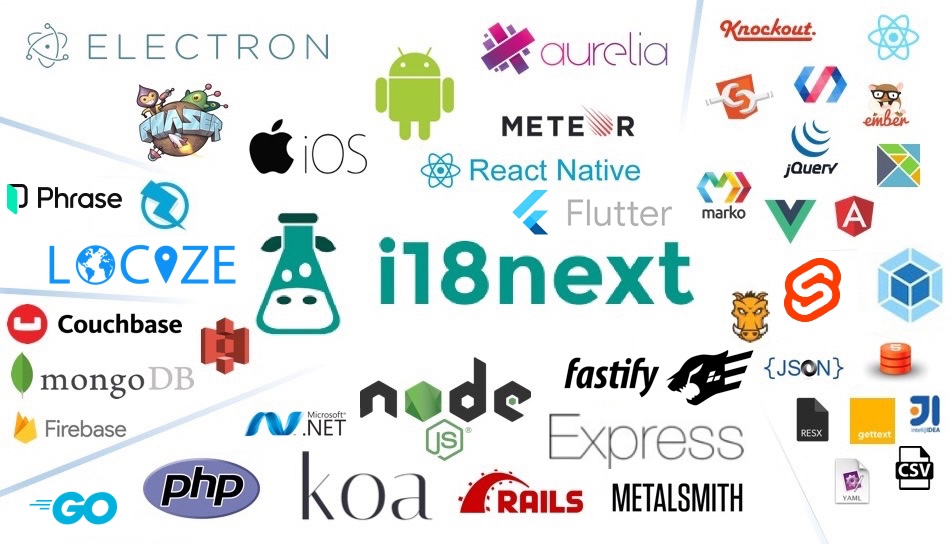Framework Compatibility
- i18next:
Framework-agnostic and can be used with various frameworks including React, Vue, and Angular, offering great flexibility.
- react-i18next:
Optimized for React, providing hooks and components that simplify the integration of i18next into React applications.
- vue-i18n:
Specifically designed for Vue.js, offering a straightforward API for managing translations in Vue components.
- @ngx-translate/core:
Designed specifically for Angular applications, providing seamless integration with Angular's dependency injection and change detection.
- @ngx-translate/http-loader:
Works in conjunction with @ngx-translate/core for Angular, enabling HTTP loading of translation files.
- next-i18next:
Tailored for Next.js applications, providing specific optimizations for server-side rendering and static site generation.
- angular-translate:
Built for AngularJS applications, making it suitable for legacy projects but not for Angular (2+) frameworks.
Translation Management
- i18next:
Offers a comprehensive translation management system with support for namespaces, pluralization, and context, making it suitable for complex applications.
- react-i18next:
Includes features like translation caching and lazy loading, making it efficient for managing translations in React apps.
- vue-i18n:
Supports message formatting, pluralization, and interpolation, providing a rich set of tools for managing translations.
- @ngx-translate/core:
Allows for dynamic loading and switching of translations at runtime, making it easy to manage multilingual content.
- @ngx-translate/http-loader:
Facilitates loading translation files from a server, supporting remote translation management.
- next-i18next:
Integrates i18next with Next.js, allowing for automatic language detection and server-side rendering of translations.
- angular-translate:
Provides a simple key-value approach for translations, but lacks advanced features found in newer libraries.
Performance
- i18next:
Highly performant with features like caching and preloading of translations, ensuring minimal lag during language switching.
- react-i18next:
Offers excellent performance with features like memoization and lazy loading, minimizing unnecessary re-renders in React applications.
- vue-i18n:
Efficiently manages translations in Vue.js, with reactive updates that ensure performance is maintained even in larger applications.
- @ngx-translate/core:
Optimized for Angular, it uses observables to update translations in real-time without reloading the entire application.
- @ngx-translate/http-loader:
Performance is dependent on the speed of the HTTP requests for loading translation files, which can be mitigated by caching.
- next-i18next:
Optimized for Next.js, it supports server-side rendering which can improve performance by preloading translations on the server.
- angular-translate:
Performance can be an issue in large applications due to its reliance on AngularJS's digest cycle, which may lead to slower updates.
Ease of Use
- i18next:
Feature-rich but may have a steeper learning curve due to its extensive capabilities and configuration options.
- react-i18next:
User-friendly with hooks and components that make it easy to implement translations in React applications.
- vue-i18n:
Straightforward API that integrates well with Vue.js, making it easy to manage translations within Vue components.
- @ngx-translate/core:
Provides a straightforward API for managing translations, making it easy for developers familiar with Angular.
- @ngx-translate/http-loader:
Simple integration with @ngx-translate/core, but requires understanding of HTTP requests for loading translations.
- next-i18next:
Simplifies the integration of i18next into Next.js, making it user-friendly for developers familiar with Next.js.
- angular-translate:
Easy to use for basic translations, but may require additional work for more complex scenarios.
Community and Support
- i18next:
Has a large community and extensive documentation, providing plenty of resources for developers.
- react-i18next:
Strong community backing with extensive documentation and examples available for React developers.
- vue-i18n:
Active community with good documentation, making it easy for Vue.js developers to find help and resources.
- @ngx-translate/core:
Well-supported within the Angular community, but may not have as extensive resources as larger libraries.
- @ngx-translate/http-loader:
Support is primarily through the Angular community, with limited standalone resources.
- next-i18next:
Growing community support as it is relatively new, with good documentation tailored for Next.js users.
- angular-translate:
Limited support as it is primarily for legacy AngularJS applications, with fewer updates and community engagement.





























